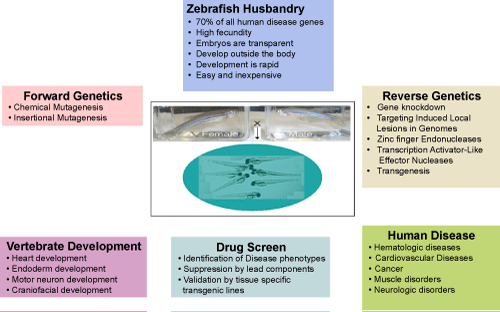
 |
| Figure 1: Zebrafish as a Genetic and Developmental Model. Zebrafish has emerged as a powerful system to model vertebrate disease and development using various molecular and genetic tools. Zebrafish genome possesses a high degree of similarity to that of humans. The other advantages of using the zebrafish model include the generation of large numbers of embryos per cross, transparency and development outside the body. Development is rapid, and embryos are comparatively easy and inexpensive to grow and maintain. The success of the “Big forward genetic screen” commonly referred as “Tübingen/ Boston screens” generated significant impact on the use of zebrafish as a promising system to model disease and development. Recent establishment of various reverse genetic approaches as listed in the above figure serves as a promising tool to interrogate the function of target genes. Application of both forward and reverse genetic approaches in the zebrafish model will uncover the roles and biological functions of many genes involved and to gain insights about the associated signaling pathways during development including namely heart and craniofacial development and disease processes including blood disorders, cardiovascular diseases and cancer. The use of zebrafish in the drug screening approach potentially facilitates fast and cost-effective identification of potential lead components and initial validation as potential therapeutics. |